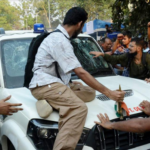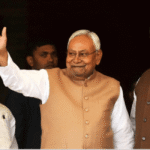In Online Frauds a recent high-profile address, Union Home Minister Amit Shah has called on police chiefs across the country to bolster their efforts in monitoring rogue drones and addressing online frauds. His directive underscores a growing concern over emerging threats that have the potential to undermine national security and public safety. Shah’s speech also emphasized the need for enhanced cooperation between the National Investigation Agency (NIA) and State Anti-Terrorist Squads (ATS) to fortify India’s counter-terrorism architecture.
Context and Importance of the Address
Amit Shah’s address comes at a time when India is grappling with a range of security challenges, including the misuse of technology for criminal and terrorist activities. The rapid advancement of drone technology and the proliferation of digital platforms have opened new avenues for illegal activities, prompting a need for a strategic response from law enforcement agencies.
The focus on rogue drones reflects concerns about their potential use for smuggling, surveillance, and even terrorist attacks. Meanwhile, the rise in online frauds, including phishing, identity theft, and financial scams, poses significant risks to individuals and organizations alike.
Addressing Rogue Drones: A Growing Threat
The use of drones has expanded significantly in recent years, with applications ranging from recreational use to commercial and industrial purposes. However, their potential for misuse has also become a major security concern.
Key Points from Amit Shah’s Directive:
- Enhanced Surveillance: Police chiefs have been instructed to implement advanced surveillance systems to detect and track unauthorized drone activities. This includes setting up dedicated teams and technologies to monitor airspace and identify rogue drones.
- Regulation and Compliance: Shah emphasized the need for strict enforcement of drone regulations, ensuring that operators comply with safety and security standards. This involves coordinating with aviation authorities to streamline drone registration and usage protocols.
- Inter-Agency Collaboration: Increased Online Frauds cooperation between local law enforcement agencies and central security forces is crucial for effective drone monitoring. This collaboration should also extend to intelligence sharing and joint operations.
Challenges in Drone Surveillance:
- Technological Advancements: The rapid evolution of drone technology, including the development of small, stealthy drones, poses challenges for detection and interception.
- Regulatory Gaps: There are gaps in existing regulations that need to be addressed to cover emerging threats and technologies.
Quote from Amit Shah: Online Frauds “Rogue drones present a serious security challenge that requires immediate and decisive action. We must leverage technology and collaboration to stay ahead of potential threats and ensure the safety of our airspace.”
Combatting Online Frauds: A Growing Concern
Online frauds have surged with the increasing reliance on digital platforms for financial transactions and personal communications. Fraudulent schemes such as phishing, identity theft, and financial scams have become more sophisticated, necessitating a robust response from law enforcement.
Key Points from Amit Shah’s Directive:
- Strengthening Cyber Crime Units: Police chiefs are advised to bolster their cyber crime units with specialized training and tools to handle online fraud cases effectively. This includes investing in digital forensics and cybersecurity expertise.
- Public Awareness Campaigns: Shah stressed the importance of educating the public about online fraud risks and preventive measures. Awareness campaigns should be conducted to inform citizens about common scams and how to protect themselves.
- Coordination with Financial Institutions: Collaboration with banks and financial institutions is essential to detect and prevent fraudulent transactions. Law enforcement agencies should work closely with these entities to trace and address frauds.
Challenges in Tackling Online Frauds:
- Evolving Techniques: Fraudsters continuously adapt their techniques, making it difficult for law enforcement to keep up. Constant updates to fraud detection methods and tools are required.
- Jurisdictional Issues: Online fraud often involves perpetrators operating from different jurisdictions, complicating investigation and prosecution.
Quote from Amit Shah: “Online frauds are a growing menace that threatens individuals and businesses alike. It is imperative that we enhance our capabilities and work together to combat these crimes effectively.”
Strengthening Counter-Terrorism Architecture
Amit Shah’s address also highlighted the need for stronger coordination between the National Investigation Agency (NIA) and State Anti-Terrorist Squads (ATS). This cooperation is vital for improving India’s counter-terrorism framework and responding to evolving threats.
Key Points from Amit Shah’s Directive:
- Integrated Approach: The NIA and ATS should adopt an integrated approach to counter-terrorism, sharing intelligence and resources to tackle terrorist threats more effectively. This includes joint operations and coordinated strategies.
- Capacity Building: Investment in training and technology for both the NIA and ATS is crucial for enhancing their operational capabilities. This includes upgrading surveillance systems, intelligence gathering methods, and investigative techniques.
- Inter-Agency Communication: Improving communication channels between different agencies involved in counter-terrorism efforts is essential for timely and effective responses to threats.
Challenges in Counter-Terrorism Efforts:
- Complex Threats: Terrorist organizations often use complex tactics and networks, making it challenging to predict and counter their activities.
- Resource Allocation: Ensuring adequate resources and support for both the NIA and ATS is necessary for effective counter-terrorism operations.
Quote from Amit Shah: “Our counter-terrorism efforts must be robust and well-coordinated. Strengthening the collaboration between the NIA and ATS will enhance our ability to address terrorist threats and ensure national security.”
The Role of Technology and Innovation
The effective monitoring of rogue drones and the combatting of online frauds both rely heavily on technological advancements. Amit Shah’s directive underscores the need for leveraging cutting-edge technology to address these challenges.
Technological Solutions:
- Drone Detection Systems: Advanced radar systems, signal jamming technology, and drone detection algorithms are crucial for monitoring and intercepting unauthorized drones.
- Cybersecurity Tools: Enhanced cybersecurity tools, including AI-based fraud detection systems and secure communication channels, are essential for addressing online fraud.
Future Directions:
- Research and Development: Continued investment in R&D for new technologies and solutions is necessary to stay ahead of emerging threats.
- Public-Private Partnerships: Collaborations between government agencies and private sector companies can drive innovation and improve response capabilities.
Conclusion
Amit Shah’s recent address to police chiefs emphasizes the importance of addressing emerging security threats with a proactive and coordinated approach. The focus on monitoring rogue drones, tackling online frauds, and strengthening counter-terrorism measures highlights the need for enhanced capabilities and cooperation among law enforcement agencies.
As India faces evolving challenges in the realms of technology and security, the directives issued by the Home Minister aim to equip police forces with the tools and strategies needed to protect national interests and ensure public safety. By embracing technological advancements and fostering inter-agency collaboration, India can enhance its ability to respond to threats effectively and uphold its commitment to security and justice. ALSO READ:- Karnataka Governor Seeks Details of Prosecution Sanctions Against Corruption-Tainted Officials: Rising Tensions with Congress Government 2024





